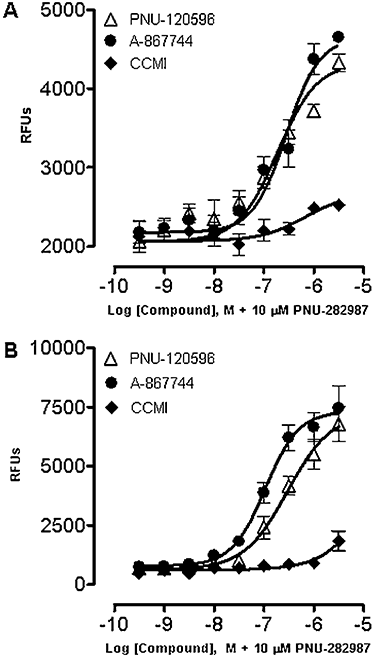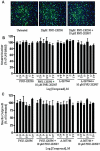Positive allosteric modulation of alpha7 neuronal nicotinic acetylcholine receptors: lack of cytotoxicity in PC12 cells and rat primary cortical neurons
- PMID: 20050184
- PMCID: PMC2807647
- DOI: 10.1111/j.1476-5381.2009.00474.x
Positive allosteric modulation of alpha7 neuronal nicotinic acetylcholine receptors: lack of cytotoxicity in PC12 cells and rat primary cortical neurons
Abstract
Background and purpose: alpha7-Nicotinic acetylcholine receptors (alpha7 nAChRs) play an important role in cognitive function. Positive allosteric modulators (PAMs) amplify effects of alpha7 nAChR agonist and could provide an approach for treatment of cognitive deficits in neuropsychiatric diseases. PAMs can either predominantly affect the apparent peak current response (type I) or increase both the apparent peak current response and duration of channel opening, due to prolonged desensitization (type II). The delay of receptor desensitization by type II PAMs raises the possibility of Ca2+-induced toxicity through prolonged activation of alpha7 nAChRs. The present study addresses whether type I and II PAMs exhibit different cytotoxicity profiles.
Experimental approach: The present studies evaluated cytotoxic effects of type I PAM [N-(4-chlorophenyl)]-alpha-[(4-chlorophenyl)-aminomethylene]-3-methyl-5-isoxazoleacet-amide (CCMI) and type II PAM 1-[5-chloro-2,4-dimethoxy-phenyl]-3-[5-methyl-isoxazol-3-yl]-urea (PNU-120596), or 4-[5-(4chloro-phenyl)-2-methyl-3-propionyl-pyrrol-1-yl]-benzenesulphonamide (A-867744). The studies used cultures of PC12 cells and primary cultures of rat cortical neuronal cells.
Key results: Our results showed that neither type I nor type II PAMs had any detrimental effect on cell integrity or cell viability. In particular, type II PAMs did not affect neuron number and neurite outgrowth under conditions when alpha7 nAChR activity was measured by Ca2+ influx and extracellular signal-regulated kinases 1 and 2 phosphorylation, following exposure to alpha7 nAChR agonists.
Conclusions and implications: This study demonstrated that both type I and type II alpha7 nAChR selective PAMs, although exhibiting differential electrophysiological profiles, did not exert cytotoxic effects in cells endogenously expressing alpha7 nAChRs.
Figures





References
-
- Anderson DJ, Bunnelle WH, Surber BW, Du J, Surowy CS, Tribollet E. 3H]A-585539[(1S,4S)-2,2-dimethyl-5-(6-phenylpyridazin-3-yl)-5-aza-2-azoniabicyclo [2.2.1]heptane], a novel high-affinity alpha7 neuronal nicotinic receptor agonist: radioligand binding characterization to rat and human brain. J Pharmacol Exp Ther. 2008;324:179–187. - PubMed
-
- Bertrand D, Gopalakrishnan M. Allosteric modulation of nicotinic acetylcholine receptors. Biochem Pharmacol. 2007;74:1155–1163. - PubMed
-
- Bettany JH, Levin ED. Ventral hippocampal alpha 7 nicotinic receptor blockade and chronic nicotine effects on memory performance in the radial-arm maze. Pharmacol Biochem Behav. 2001;70:467–474. - PubMed
Publication types
MeSH terms
Substances
LinkOut - more resources
Full Text Sources
Miscellaneous

